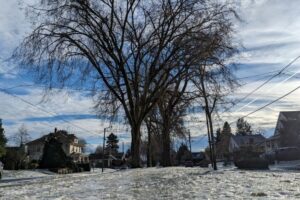Together we can protect trees and our communities: Friends of Trees Op-Ed

On January 21st, The Oregonian published an op-ed written by Yashar Vasef, our executive director, and Litzy Venturi, our community tree care coordinator: “We must invest in tree care to protect trees and our communities.” Read the full piece below.
Opinion: We must invest in tree care to protect trees and our communities
Climate change and its severe impacts force us to live with dual realities: We need trees more than ever and we need to recognize that extreme weather can turn them into hazards. After hundreds of trees and large limbs fell around the Portland metro area during this historic winter storm, we know that people may be concerned about the trees in their neighborhoods. The impact of a downed tree is serious and often devastating.
The response is clear, but not necessarily easy. Not only do we need to continue to plant trees to grow our urban canopy, but we also need to invest more time, knowledge and resources into assessing, protecting and maintaining the trees we have. As part of that, we must also deal with trees that need to be removed and replaced due to poor health or the potential threat they pose to homes or businesses.
Trees are a crucial ingredient for a healthy, resilient and livable community. How do we set our trees up for success in the face of potential extreme weather? It starts with planting the right tree in the right place. Sometimes people favor certain species because of sentiment or aesthetic appeal, but if they aren’t planted in a place with the right conditions, they’re more prone to failure. Selecting a tree for the available space, light and soil type is the first step in giving a tree a long healthy life.
The next step is to invest in caring for young trees after they’re planted. Proper watering techniques encourage roots to spread into a wide, stable network. Mulching around a tree’s root zone provides the soil with needed nutrients and structure. The right pruning plan will allow a tree to establish a strong trunk and a stable shape and mitigate the risk of limb failure. Tree care is a lot like preventative medicine. Keeping a tree healthy will reduce the risk of catastrophic failure.
You might be looking at a large tree in your own yard and wondering what to do next. While concern after this winter storm is natural, it’s important to remember that the benefits of trees far outweigh the risks. Trees create oxygen, abate pollution and cool our neighborhoods. It’s important not to over-correct by removing healthy trees. This was an unusually catastrophic weather event, and while hundreds of trees fell, millions didn’t. Still, there are steps you can take as a tree owner, and that we can take as a community, to better care for our trees and reduce the risk of catastrophe in the future.
An arborist partner of ours, Chad Honl, pointed out in a recent Oregonian/OregonLive story that this was “a perfect storm for knocking over trees,” and that even trees he would have characterized as stable toppled over in the storm. That’s a scary prospect, especially as climate change increases chances for extreme weather. But it just means that we need to learn more about what happened – which kinds of trees fell and what factors may have made some more vulnerable to failing than others. We agree with Honl’s call for trees to be assessed and reassessed with storms like this in mind. Understanding and addressing risks in advance of the next storm can save a lot of money, trouble and even lives. If you’re worried about your tree, you should have it inspected by a certified arborist for maintenance needs and potential problems.
A greater investment in trees doesn’t just mean planting more trees. It means taking care of the trees we have. In response to the unexpected revenue from the Portland Clean Energy Fund, Portland City Commissioner Carmen Rubio has called for additional climate investments, including $100 million for the protection and maintenance of 240,000 right-of-way street trees between the sidewalk and the street. We need to protect our mature trees and protect our communities by making sure those trees are safe.
The more mature a tree gets, the more benefits it provides: more carbon storage, more air and water quality benefits, more shade, more habitat. That’s why we need to invest in the health of our trees, for our safety in the event of a winter storm or heat wave, for our daily mental and physical well-being, and for the health of the planet.
